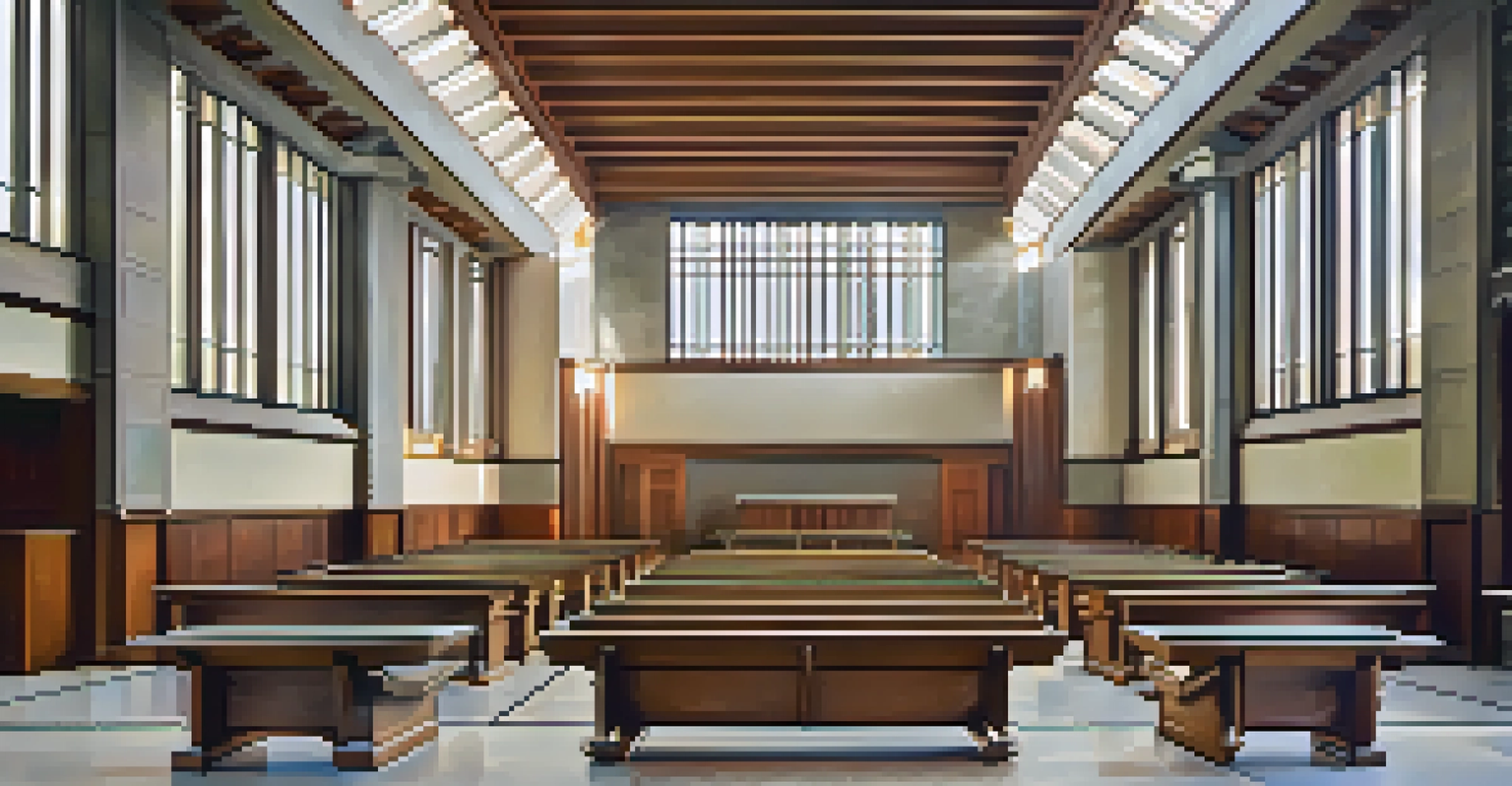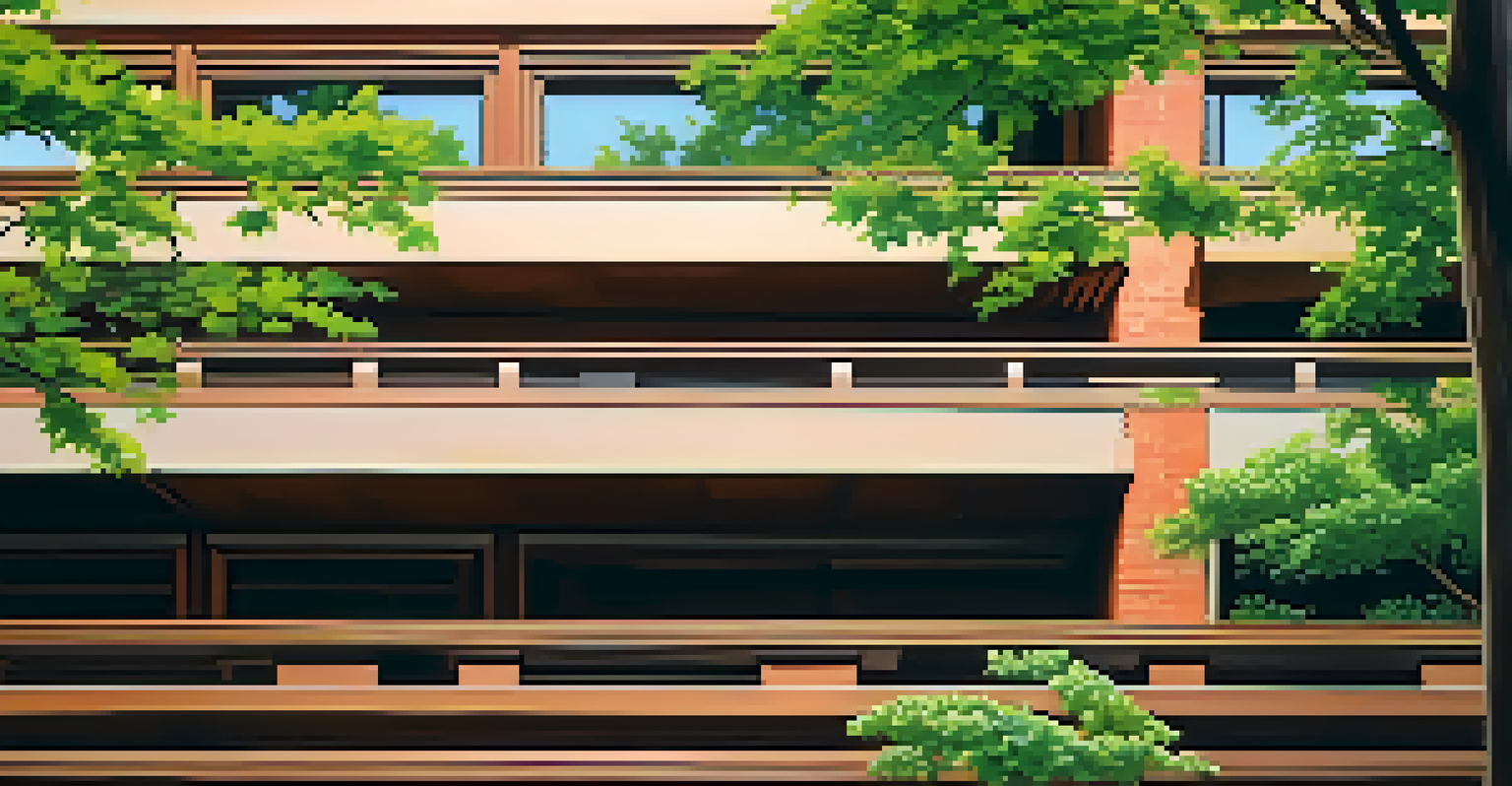Oak Park: Frank Lloyd Wright and Historic Architecture

Introduction to Oak Park's Architectural Heritage
Oak Park, a vibrant suburb of Chicago, is renowned for its rich architectural history. Nestled just a few miles from the bustling city, it boasts a unique blend of styles that reflect America's architectural evolution. From quaint bungalows to grand Victorian homes, Oak Park tells a fascinating story through its buildings.
The mother art is architecture. Without an architecture of our own, we have no soul of our own civilization.
One cannot discuss Oak Park without mentioning Frank Lloyd Wright, a key figure in American architecture. Wright's innovative designs and philosophies have left an indelible mark on the community, making it a must-visit destination for architecture enthusiasts. His works in Oak Park showcase a transition from traditional styles to modernist principles.
As we delve deeper into Oak Park's architectural landscape, we'll explore how Wright's influence shaped the area and continues to inspire future generations. Whether you're an architecture buff or a casual visitor, the stories behind these structures offer a captivating glimpse into the past.
Frank Lloyd Wright: A Brief Biography
Frank Lloyd Wright was born in 1867 and grew up in Wisconsin, where his early experiences with nature profoundly influenced his design philosophy. After studying at the University of Wisconsin, he moved to Chicago, where he worked for the renowned architect Louis Sullivan. This experience ignited his passion for blending architecture with the natural environment.

Wright eventually established his own practice and developed the Prairie School style, characterized by horizontal lines and integration with the landscape. His innovative approach aimed to create structures that harmonized with their surroundings, a stark contrast to the ornate styles of the time. This philosophy would become a hallmark of his work.
Frank Lloyd Wright's Influence
Frank Lloyd Wright's innovative architectural styles, particularly the Prairie School, have significantly shaped Oak Park's identity.
Throughout his career, Wright designed over 1,000 structures, with many of his most significant works located in Oak Park. His ability to marry functionality with artistry set a new standard in architecture, influencing countless architects and shaping the future of American design.
The Prairie Style: Wright's Signature Approach
Wright's Prairie School style emerged in the late 19th and early 20th centuries, emphasizing simplicity and a connection to the landscape. Characterized by low-pitched roofs, wide eaves, and open floor plans, this style aimed to create a sense of harmony between the home and its environment. The use of natural materials further enhanced this connection.
Simplicity and repose are the qualities that measure the true value of any work of art.
In Oak Park, Wright's designs, such as the Robie House and the Unity Temple, exemplify the Prairie style's principles. These buildings showcase his innovative use of space and light, allowing for a seamless flow between interior and exterior. Visitors can truly appreciate how these structures blend into their surroundings, creating a tranquil atmosphere.
The Prairie style not only transformed residential architecture but also influenced public buildings and commercial spaces. This legacy is evident in Oak Park, where Wright's vision has left a lasting impact on the community's architectural identity.
Notable Wright Structures in Oak Park
Oak Park is home to several of Frank Lloyd Wright's most notable designs, including the famous Robie House. This iconic residence, completed in 1910, showcases Wright's Prairie style with its low profile and expansive terrace. Visitors often marvel at the harmonious relationship between the house and its lush surroundings.
Another significant structure is Unity Temple, built between 1905 and 1908. This Unitarian Universalist church features a unique design that breaks away from traditional religious architecture. Its use of concrete and geometric forms reflects Wright's innovative spirit, creating a space that is both serene and inspiring.
Exploring Architectural Tours
Visitors can delve into Oak Park's architectural heritage through guided and self-guided tours that highlight key structures.
These buildings, along with others like the Frank Lloyd Wright Home and Studio, are not just architectural wonders; they are also places where history and community intersect. Each structure tells a story, inviting visitors to explore Wright's vision and the cultural context of his time.
Visiting Oak Park: Architectural Tours
For those eager to explore Oak Park's architectural treasures, several guided tours are available. These tours provide an in-depth look at Wright's works and the broader historical context of the area. Knowledgeable guides share intriguing anecdotes and insights, enhancing the visitor experience.
Self-guided walking tours are also an option for those who prefer to explore at their own pace. With maps highlighting significant buildings, visitors can stroll through the charming streets and appreciate the unique architectural styles that characterize Oak Park. This approach allows for a more personal connection with the structures.
Whether you choose a guided tour or a leisurely walk, Oak Park offers a wealth of architectural wonders waiting to be discovered. Each corner reveals a new story, making it a delightful experience for architecture lovers and casual visitors alike.
The Impact of Wright's Work on Modern Architecture
Frank Lloyd Wright's innovative designs have had a profound impact on modern architecture, influencing generations of architects. His emphasis on organic architecture—designing structures that are in harmony with the environment—has become a guiding principle for many contemporary architects. This focus on sustainability and integration continues to resonate today.
Wright's ideas about open floor plans and the use of natural light paved the way for the modern home design we see now. His belief that architecture should enhance the quality of life is a concept that remains relevant as we seek to create spaces that foster well-being and connection with nature. This legacy is evident in many new constructions around the world.
Preservation of Architectural Legacy
The community actively works to preserve Oak Park's architectural history, ensuring that Wright's legacy endures for future generations.
In Oak Park, Wright's influence can still be felt in the community's ongoing commitment to preserving its architectural heritage. The blend of historical preservation and modern innovation exemplifies how Wright's vision continues to inspire and shape architectural practices today.
Preserving Oak Park's Architectural Legacy
The preservation of Oak Park's architectural history is a community effort, with local organizations dedicated to maintaining and promoting its unique buildings. These groups work tirelessly to ensure that both Wright's structures and the broader architectural landscape are protected for future generations. Their efforts highlight the importance of heritage in fostering a sense of place.
In addition to preservation efforts, Oak Park hosts events and activities that celebrate its architectural legacy. From home tours to lectures and exhibitions, the community engages residents and visitors alike in the appreciation of its rich history. These initiatives not only educate but also foster a sense of pride in the area's architectural heritage.

As we look to the future, the ongoing commitment to preserving Oak Park's architectural treasures ensures that Frank Lloyd Wright's legacy will continue to inspire. By cherishing these historic structures, the community honors the past while paving the way for future generations to explore and appreciate this remarkable architectural landscape.